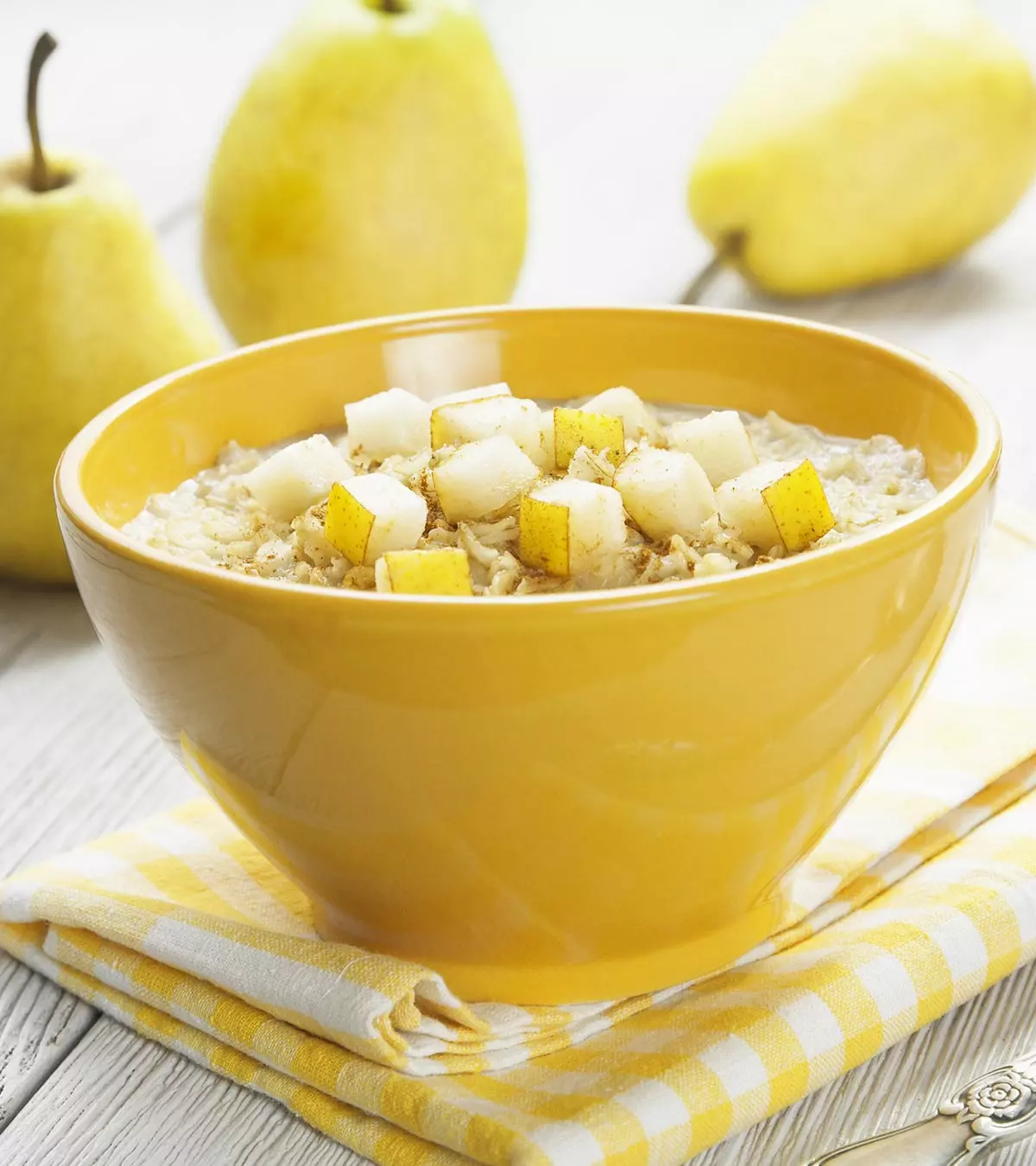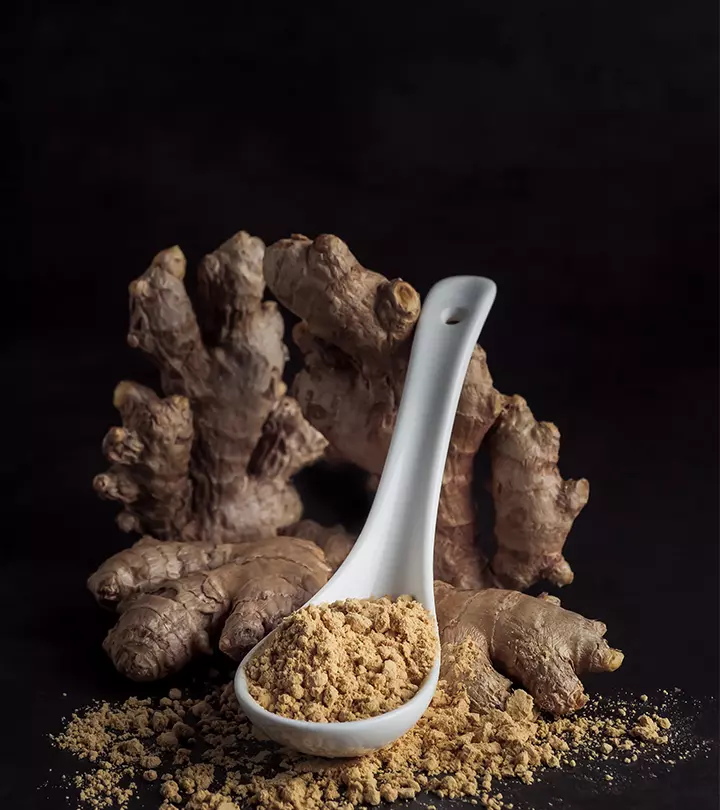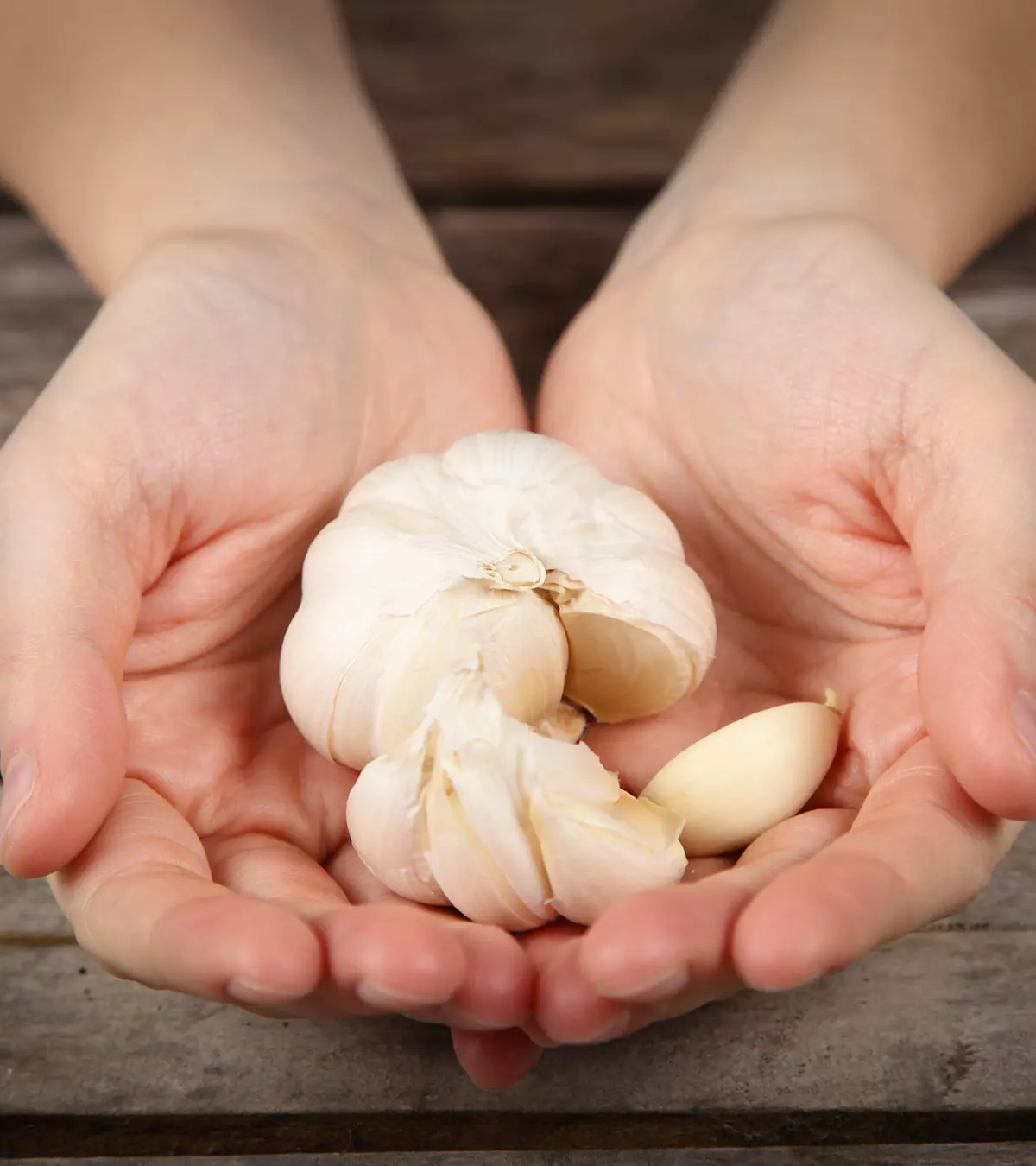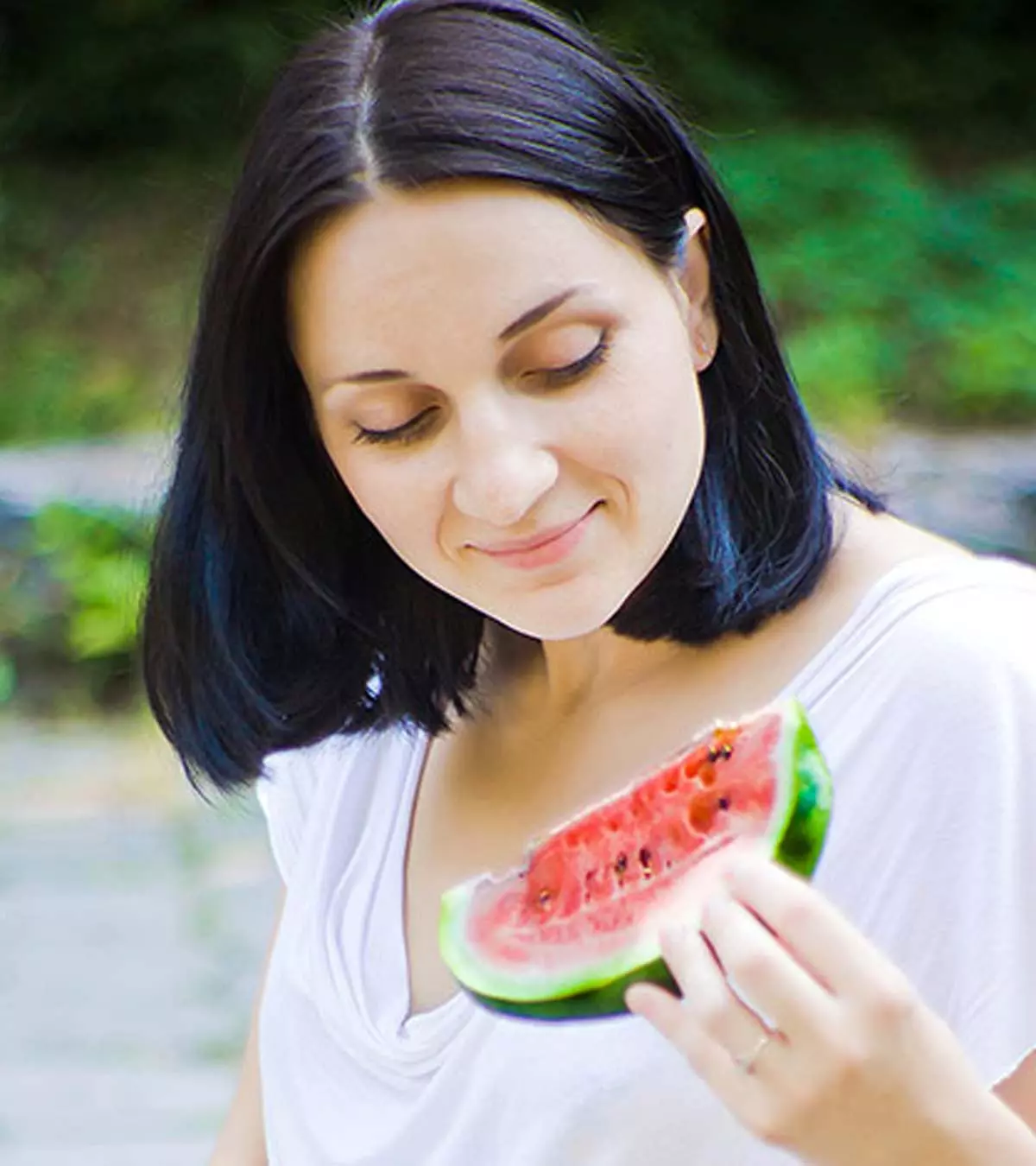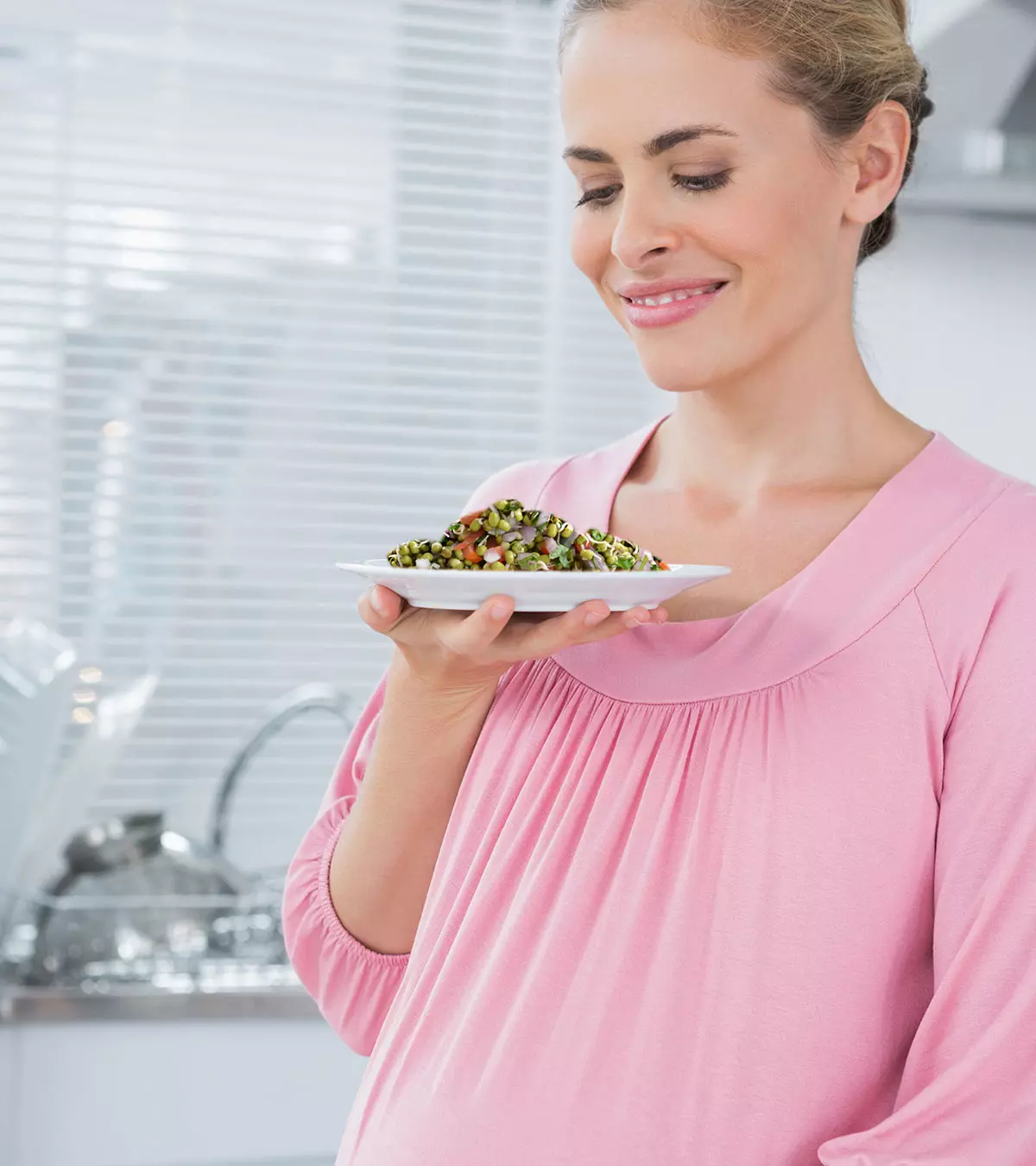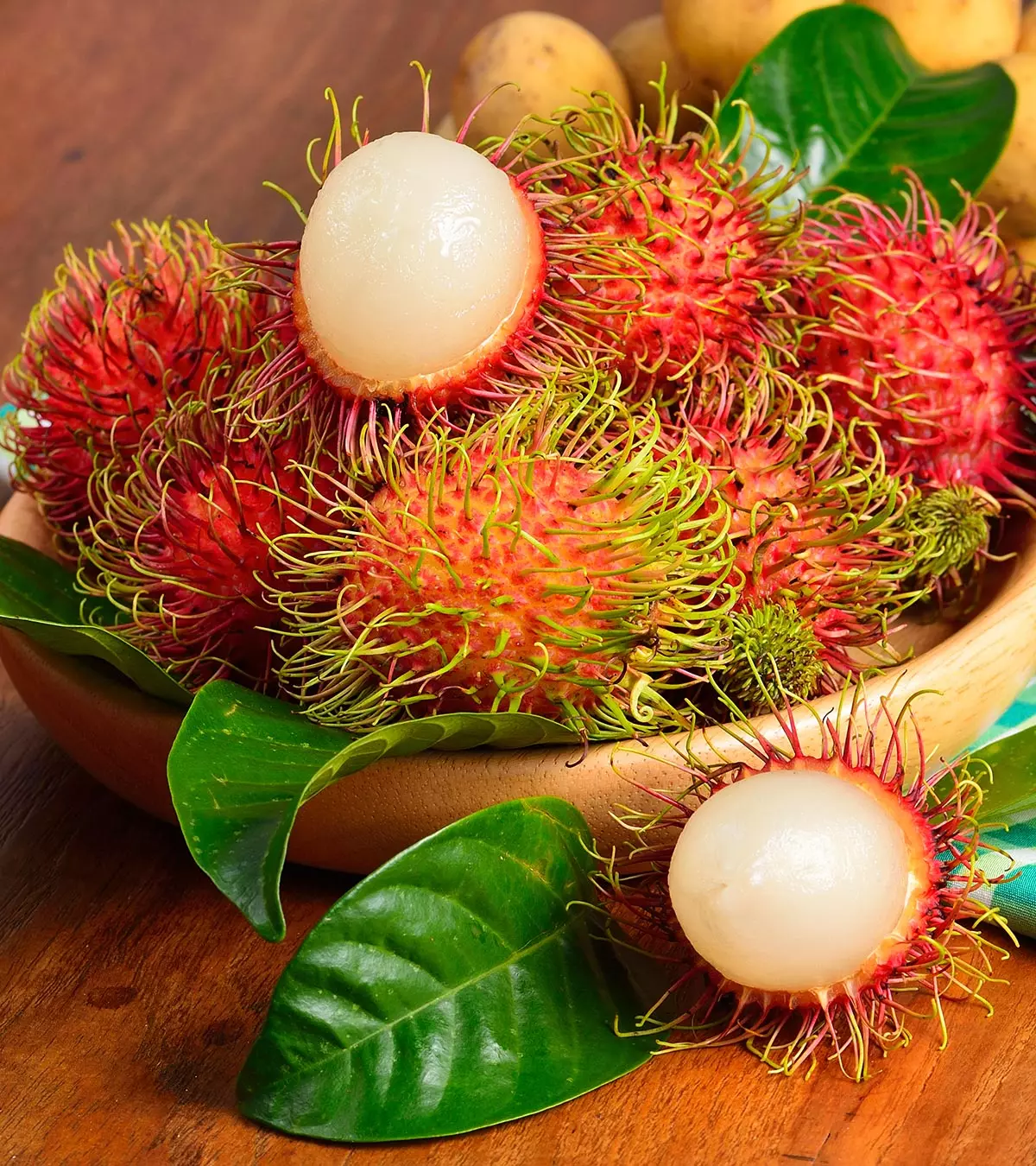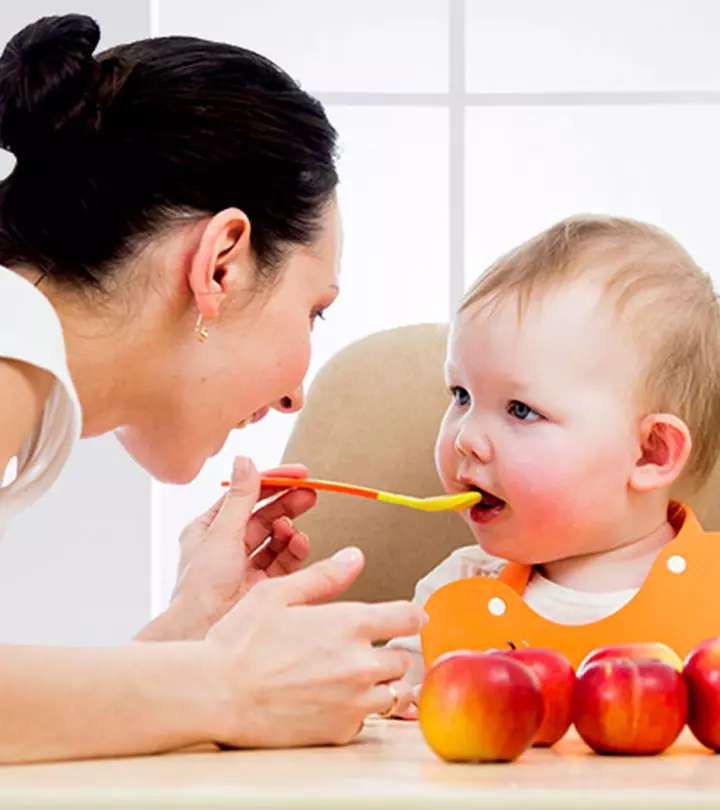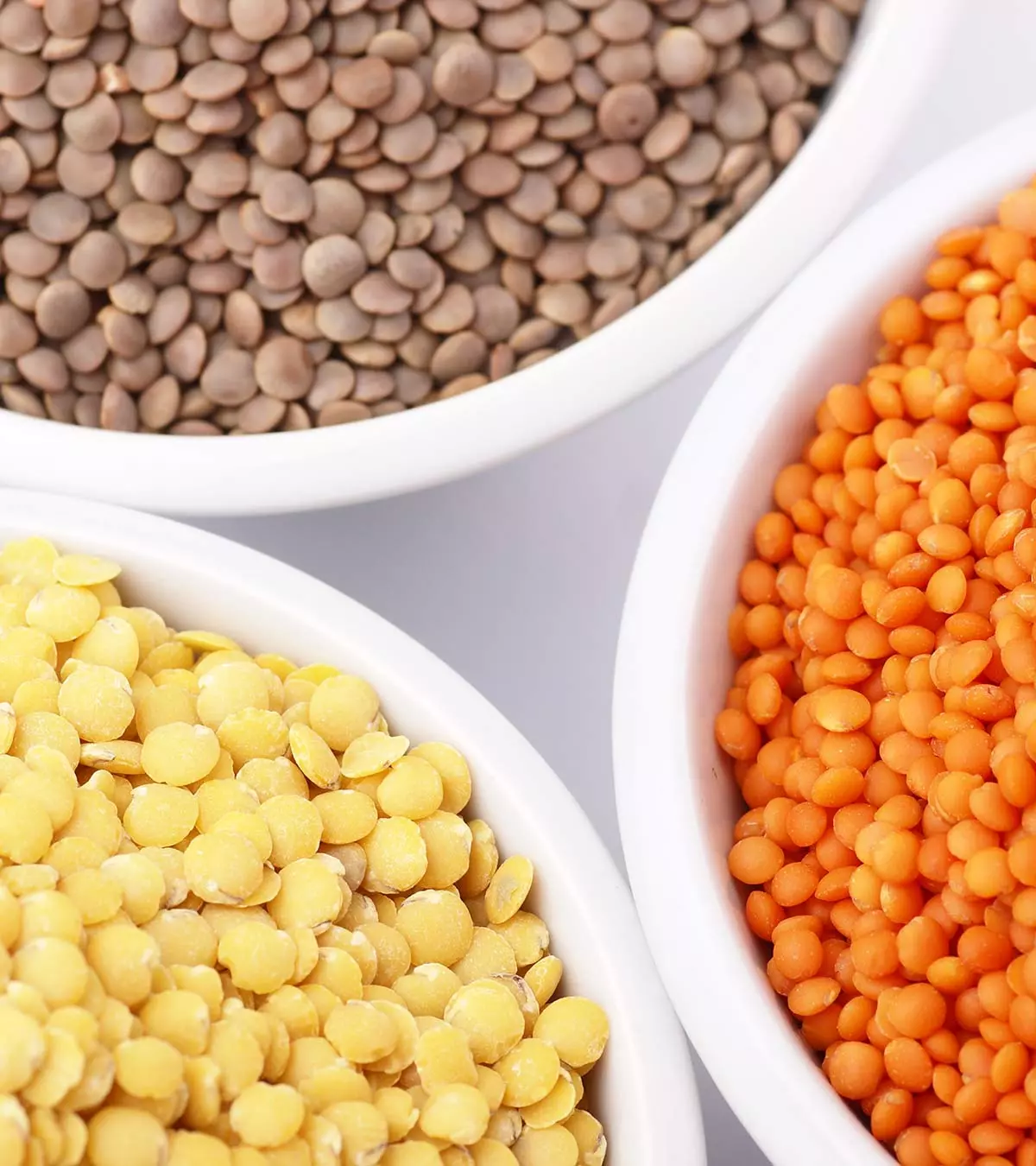
Image: ShutterStock
Lentils for babies can be introduced as soon as they begin to eat solids. It is nutritious food rich in iron and other essential nutrients and proteins. There are different varieties of lentils in various sizes and colors, and all of them are low in fat. Pulses are unavoidable in a baby’s diet. However, you may introduce them gradually in lower quantities to avoid bad effects such as excess gas formation. Read on to know the benefits of lentils for infants and learn about some delicious lentil recipes for your little ones.
Key Pointers
- Lentils are a great source of fiber and nutrients and can be introduced in moderation to babies between 8-10 months of age.
- They are rich in protein and can aid in digestion, immunity, brain development, and overall growth of the baby.
- There are many varieties of lentils available in the market, each with unique colors and textures.
- Lentils can be mashed and pureed and incorporated into the baby’s diet along with other vegetables in the form of soup, patties, or curries.
- It is ideal to maintain moderate intake of lentils to avoid bloating and flatulence in babies.
Benefits Of Lentils For Babies
, a registered dietitian from Dalton, Georgia, says, “Lentils provide essential vitamins and minerals like folate, zinc, and magnesium, supporting overall immune function and brain development. Introducing lentils to babies’ diets can help provide a diverse range of nutrients, contributing to their overall health and well-being.”
Lentils form part of sustainable diets. Although sometimes called ‘the poor man’s meat’, lentils are an important source of protein and essential minerals, and amino acids like isoleucineiAn amino acid used in protein biosynthesis. and lysine (1). They are a good source of fiber and vitamins as well and low fat, cholesterol, and sodium, all of which are essential for the growth and development of a baby (2). But you need to give them in moderation.
Here’s how lentils can be beneficial for your baby:
- Digestion: Fiber-rich foods for babies can help clear the digestive system, deal with constipation, and thus maintain regular bowel movements. A half cup of lentils has almost eight grams of fiber. Watch if your baby gets gaseous, then introduce it in very small amounts, a few tablespoonfuls a day. This could also prevent weight gain issues in later years.
- Iron: The natural iron reserves in the body reduce by the time the baby is around six months of age. That is a good time to add iron-rich foods such as lentils to the diet. These foods will help your baby stay active and energetic, besides aiding in brain development (3). Moreover, the low phyticiA chemical compound that is the prime source of phosphorous in oilseeds, nuts, grains, and legumes. acid content of lentils benefit in increased bioavailabilityiThe rate at which a drug or other chemical is absorbed by the body. of iron (4).
 Experts say
Experts say- Immunity: The zinc present in lentils promotes a healthy immune system. It also governs the way neurons function and thus impacts memory and learning, both extremely crucial for a growing baby (5) (6).
- Calcium: Cooked lentils contain approximately 19 mg of calcium per 100 gm. A healthy, growing infant between the ages of six and 11 months needs a daily intake of 270mg (7). And legumes can supply a decent amount of calcium to your baby to support bone growth and development.
- Folate: Lentils contain Folate, also known as folic acid or Vitamin-B9, which helps build new cells and is important in making DNA too. It balances the functioning of the central nervous system and is extremely crucial for babies in the years of rapid growth and development (8) (9).
- Polyphenols: Lentils have high polyphenol content that helps in promoting overall health. These polyphenols and bioactive compounds found in lentils play an important role in the prevention of degenerative diseases. Besides that, they have health-promoting effects too. These vitals thus make lentil a must-add to your baby’s meal (10).
Note
: Lentils have RFOs (Raffinose family Oligosaccharides), which may lead to bloating and flatulenceiReleasing gas from the digestive tract through the back passage. (11). Hence intake of lentils should be in moderation for babies.
Below is the nutritional composition of cooked lentils.
| Nutrient | Value per 100g |
|---|---|
| Water | 69.64g |
| Energy | 116kcal |
| Protein | 9.02g |
| Total lipid (fat) | 0.38g |
| Carbohydrate, by difference | 20.13g |
| Fiber, total dietary | 7.9g |
| Sugars, total | 1.80g |
| Calcium, Ca | 19mg |
| Iron, Fe | 3.33mg |
| Magnesium, Mg | 36mg |
| Phosphorus, P | 180mg |
| Potassium, K | 369mg |
| Sodium, Na | 2mg |
| Zinc, Zn | 1.27mg |
| Vitamin C, total ascorbic acid | 1.5mg |
| Thiamin | 0.169mg |
| Niacin | 1.060mg |
| Vitamin B-6 | 0.178mg |
| Folate, DFE | 181µg |
| Vitamin A, IU | 8IU |
| Vitamin E (alpha-tocopherol) | 0.11mg |
| Vitamin K (phylloquinone) | 1.7µg |
When To Introduce Lentils To A Baby?
Generally, pediatricians recommend adding lentils to your baby’s diet between eight and ten months of age to avoid flatulence caused by the food
. For infants aged seven to 12 months, the recommended dietary allowance for iron, according to the Institute Of Medicine, is 11mg/day (3).
Note: While feeding lentils for the first few times, add some vegetables to avoid any digestion issues. Allergies associated with lentils are very rare. However, talk to your doctor before introducing any new food to your baby.
What Types Of Lentils Are Good For Babies?
Lentils come in different sizes, shapes, and colors. Commonly used for are red lentils (masoor dal), orange lentils, and yellow lentils. Some of them cook faster while a few take longer to soften. Red lentils are smoother and cook faster than others, making them an ideal choice for purees and soup recipes for babies. The lower fiber content in them may not cause gas. Brown lentils, too, are good for baby food recipes.
Older babies enjoy well-cooked green lentils or lentils as finger foods, once they are ready for it. Other lentil varieties include black lentils and white lentils.
Cooked lentils, particularly mushed varieties, can be frozen. Cook brown or green lentils partially if you want to freeze them. Dried lentils can be stored for a year in a cool place.
Avoid canned lentils for babies as they have preservatives and are likely to give the baby gas. However, in terms of nutritional level, they are similar to dried varieties, as long as there is no extra salt or sugar added.
How To Select And Cook Lentils For Babies?
You may choose packed or loose lentils, preferably organic. Spread them out and check out for stones or debris. After a thorough check, rinse lentils under running water in a strainer.
You do not have to soak lentils before cooking. However, some people find it easy to cook if lentils are soaked for an hour. Do not discard the water used for soaking lentils as the same will contain water-soluble vitamins unless you are doing it to avoid flatulence caused by lentils (4).
 Quick tip
Quick tipDirections to cook lentils:
- Add three cups of water and one cup of lentils to a pan and bring it to a boil.
- Get the flame down and cover it with a lid. Cook for 20 to 30 minutes.
- If you want firmer lentils, cook for lesser time.
For quicker preparation, consider using an Instant Pot to cook lentils. Combine one cup of lentils with three cups of water and cook on high pressure for 10 minutes. This method retains nutrients and can save time for busy parents.
Note:
Green lentils take around 30 minutes, and red lentils take about 20 minutes to cook. Brown lentils are the slowest to cook.
Feed cooked lentils in the puree form to your baby. Add boiled vegetables to the puree to avoid digestion issues. You may also add fresh ginger and cumin to the puree to deal with digestion.
Note: Do not add sugar or salt, as it may affect the nutritional value.
Fermented or sprouted lentils too can be included as a part of your baby’s balanced diet as both these processes are known to increase the nutritional value of the food and make the digestibility of food easy (5).
Recipes To Prepare Lentils For Babies
Here are a few interesting and easy homemade lentil recipes for babies:
1. Lentils Puree With Vegetables

Preparation time: 40 minutes
You will need:
- 1tbsp oil
- 1/4 cup onion, bell pepper, tomato, green peas, sweet potatoes (chopped)
- 1/4 cup lentils (cooked)
- 1 cup water or vegetable broth
How to:
- Pour a little oil in a pan. Add onion, bell pepper, and sauté.
- After five minutes, add tomato and cook for two minutes. Add water or vegetable broth and cover the pan with a lid.
- Let it cook for 10 minutes on low flame. Switch off the flame and blend the mixture with well-cooked lentils to get desired consistency.
A mother and a food blogger, Amy Bronee, shares her recipe of lentil puree for her baby. She says, “I heat the oil in a medium saucepan over medium-high heat. I add the onion and carrot and saute for a few minutes until the veggies soften. Then, I add the lentils and two cups of water and bring it to a boil. I reduce the heat to low, cover the saucepan, and allow the lentils to simmer for 45 minutes until tender. I scoop the cooked lentils into the blender and add enough pre-boiled water to get a rolling blend… I’ve got lots more freezing in a mini muffin tray. I’ll serve them alone or in combination with a cube or two of veggie purees. (i).”
2. Lentils With Carrots And Brown Rice (Dal Rice)

Preparation time: 50 minutes
You will need:
- Water as needed
- 1/4 cup lentils or moong dal
- 1/2 cup brown rice
- 1/4 cup carrots (finely chopped)
How to:
- Add all the ingredients to a pan and allow it to boil. Add enough water.
- Lower the flame and let it cook for 30 minutes.
- Check if the lentils turned tender and soft. Once they are done, mash.
- Blend it if you desire.
3. Lentil Patties (Cakes)
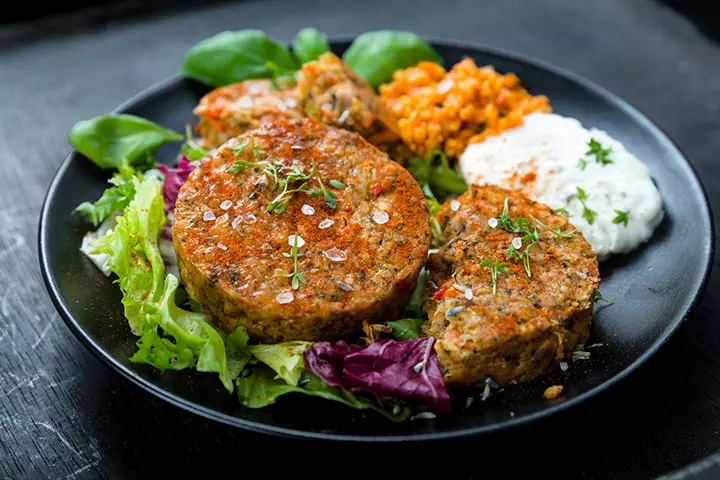
Preparation time: 60 minutes
You will need:
- 1 cup brown lentils
- 1/4 cup milk
- 2 1/2 cup water
- 1-ounce dry onion soup mix
- 1 cup barley and wheat nugget cereal
- 1/2tsp poultry (seasoning)
- 1/2 cups walnuts (chopped)
- 2 eggs (beaten)
- 2tbsp vegetable oil
- 1 cup dry breadcrumbs
How to:
- Add water and lentils to a pan and bring it to a boil. Lower the flame and cook for 20 minutes with a closed lid.
- After cooking, drain extra water and add in milk, eggs, cereal, wheat, and walnuts.
- Season with onion soup mix and poultry seasoning as well. Mix well and let it stand for 30 minutes or refrigerate overnight.
- Pour oil into a skillet and heat on medium flame. Scoop out the mixture and roll the balls in breadcrumbs. Flatten the patties and fry them in the oil for five minutes.
- Serve warm once they turn golden brown on both sides.
4. Pureed Lentil Soup With Apricots
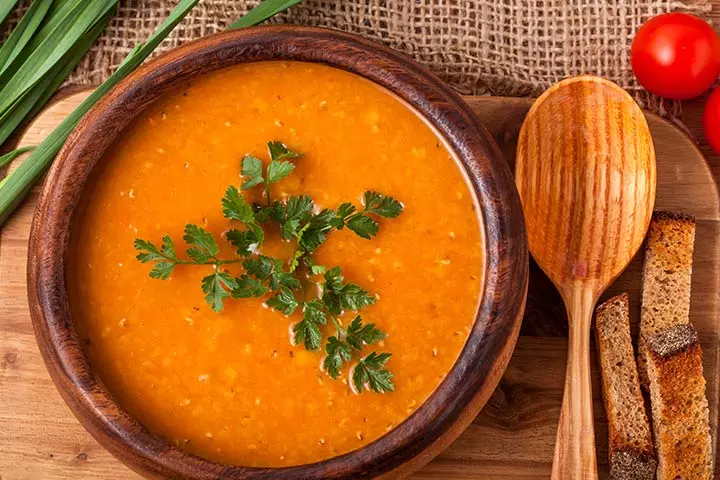
Preparation time: 60 minutes
You will need:
- 1tbsp olive oil
- 1 cup red lentils
- 1 carrot (peeled, cut)
- 1 onion (diced)
- 1 tsp ground cumin
- 1/2 cup dried apricots (chopped)
- 3 1/4 cup water
How to:
- Sauté carrots and onions in hot oil for 10 minutes. Add cumin and lower the flame.
- Add vegetables, lentils, and enough water. Bring them to boil. Lower the flame and cook for 20 minutes.
- Cool the mixture, transfer it to a blender, and puree it. Add the apricots and puree further.
 Quick tip
Quick tip5. Curried Lentils
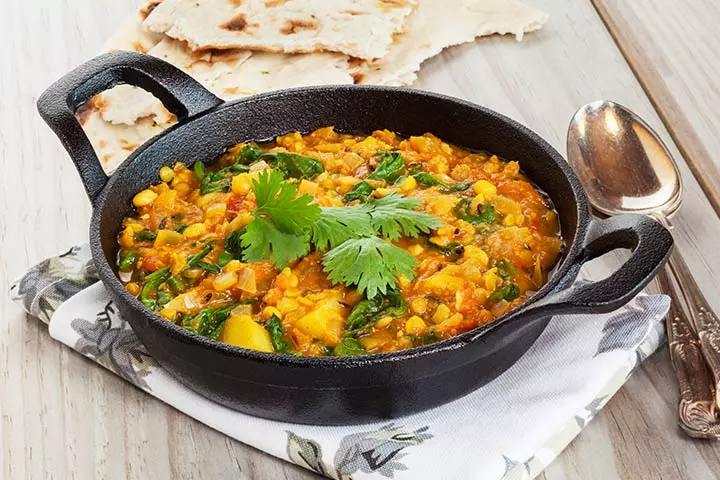
Preparation time: 30 minutes
You will need:
- 1/2 cup carrots, onion, celery (chopped)
- 2 cloves garlic
- 1 cup lentils
- Tofu
How to:
- Sauté vegetables, cloves, and tofu cubes. Add these to lentils that have been cooking.
- Add curry powder for taste.
6. Lentil And Sweet Potato Soup
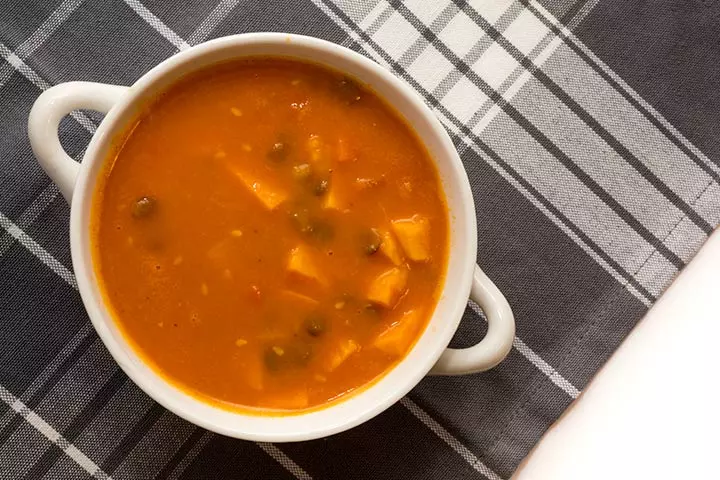
Preparation time: 30 minutes
You will need:
- 1tbsp pigeon peas (toor dal, arhar dal) or lentils
- ¼ sweet potato (peeled, chopped)
- a pinch of dry roasted cumin
- 2 cups of water
How to:
- Add all the ingredients into a pan and cook well.
- Mash them and strain through a sieve.
Frequently Asked Questions
1. Are lentils hard for babies to digest?
When compared to other pulses, lentils are easier for babies to digest. However, they have also been known to cause discomfort while digesting and increase the risk of pulmonary aspirationiCondition in which food, fluids, and other contents go down the trachea into the lungs rather than going down the esophagus into the stomach. while swallowing (13).
2. How often can a baby eat lentils?
Feeding lentils to babies when they start having solid food is safe, and around one to two servings per day is good (14).
3. How do lentils compare to other types of legumes, such as chickpeas or kidney beans, in terms of nutrition and taste?
In terms of nutrition, lentils, and other legumes, such as chickpeas and kidney beans are similar. They contain proteins, flavonoids, and a high fiber content, like all pulses. However, their preparation time differs. Lentils do not require soaking, whereas chickpeas and kidney beans require significant soaking time before cooking. Additionally, you can explore various recipes with lentils and legumes and customize them according to your taste and preferences (19).
If your baby is already consuming solid foods like cereals and grains, you may supplement their diet with iron, protein, and fiber-rich lentils. In addition, lentils make for a great choice to introduce to your baby as a part of baby-led weaning. You may include lentils in their meals with sweet potato soup, dry beans, white potatoes, grapes, peaches, apples, pork, and tofu to make them tastier. However, know that lentils should only be consumed in moderation since excessive intake might induce flatulence. Also, whether you buy loose lentils or packaged ones, make sure to wash them thoroughly before cooking.
Infographic: Tips On Selecting And Cooking Lentils
Rich in protein, fiber, and vitamins, lentils are a whole package of healthy goodness. So you may give your baby their daily dose of nutrients by cooking these and feeding them in moderation. But before you experiment with recipes, learn how to select and cook lentils properly for your little one. Illustration: Momjunction Design Team
Illustration: Lentils For Babies: When To Start Benefits And Recipes

Image: Stable Diffusion/MomJunction Design Team
Personal Experience: Source
MomJunction articles include first-hand experiences to provide you with better insights through real-life narratives. Here are the sources of personal accounts referenced in this article.
i. Baby food – brown lentils;http://www.familyfeedbag.com/2011/07/baby-food-brown-lentils.html
References
1. Ali Kahraman; Nutritional Components and Amino Acids in Lentil Varieties; Research Gate (2016)
2. Geoffrey P. Savage;Lentils: a Forgotten Crop;Sage Journals (1991)
3. John L. Beard; Why Iron Deficiency Is Important in Infant Development; National Center For Biotechnology Information (2008)
4. Dil Thavarajah;Lentil (Lens culinaris Medikus): A Whole Food Rich in Prebiotic Carbohydrates to Combat Global Obesity;Semantic Scholars
5. Nour Zahi Gammoh and Lothar Rink; Zinc in Infection and Inflammation; National Center For Biotechnology Information (2017)
6. Narpinder Singh; Pulses: an overview; National Center For Biotechnology Information (2017)
7. Nutritional needs of infants; Children’s hospital Los Angeles
8. Yen-Ming Chan; Folate; National Center for Biotechnology Information (2013)
9. Reynolds E; Vitamin B12, folic acid, and the nervous system; National Center for Biotechnology Information (2006)
10. Kumar Ganesan and Baojun Xu;Polyphenol-Rich Lentils and Their Health Promoting Effects;National Centre for Biotechnology Information (2017)
11. Udhaya Kannan; Biochemical And Molecular Characterisation of RFO Biosynthesis In Lentils (Lens culinaris Medik.); Semantic Scholars
12. Lentils, mature seeds, cooked, boiled, without salt; Basic Report: 16070;USDA
13. The Committee on Nutrition; Diagnosis and Prevention of Iron Deficiency and Iron-Deficiency Anemia in Infantsand Young Children (0–3 Years of;American Academy of Pediatrics (2010)
14. Pulses;Canadian Society of Intestinal Research
15. Smith G. Nkhata; Fermentation and germination improve nutritional value of cereals and legumes through activation of endogenous enzymes;National Center For Biotechnology Information (2018)
16. Lentils; Louis Bonduelle Foundation
17. Feeding your baby (aged nine months to a year); Nidirect
18. https://health.clevelandclinic.org/health-benefits-of-lentils
19. How do lentils compare nutritionally to dried beans like kidney beans, black beans and chickpeas?; American Institute of Cancer Research
Community Experiences
Join the conversation and become a part of our nurturing community! Share your stories, experiences, and insights to connect with fellow parents.
Read full bio of Jyoti Benjamin
- Trista Best is a registered dietitian at Balance One Supplements, Environmental Health Specialist, and Adjunct Nutrition Professor. She completed her Masters of Public Health Nutrition from Liberty University and BS Dietetics from the University of Alabama before getting Dietitian Registration in 2018.
 Trista Best is a registered dietitian at Balance One Supplements, Environmental Health Specialist, and Adjunct Nutrition Professor. She completed her Masters of Public Health Nutrition from Liberty University and BS Dietetics from the University of Alabama before getting Dietitian Registration in 2018.
Trista Best is a registered dietitian at Balance One Supplements, Environmental Health Specialist, and Adjunct Nutrition Professor. She completed her Masters of Public Health Nutrition from Liberty University and BS Dietetics from the University of Alabama before getting Dietitian Registration in 2018.
Read full bio of Swati Patwal
Read full bio of Rohit Garoo
Read full bio of Ghazia Shah









